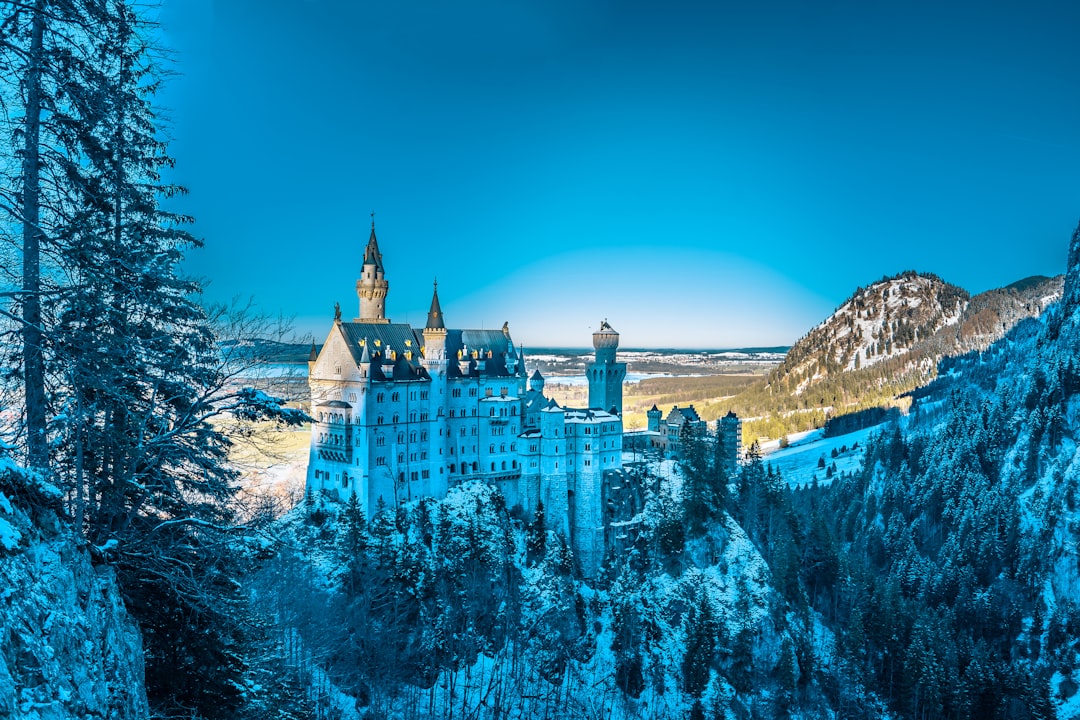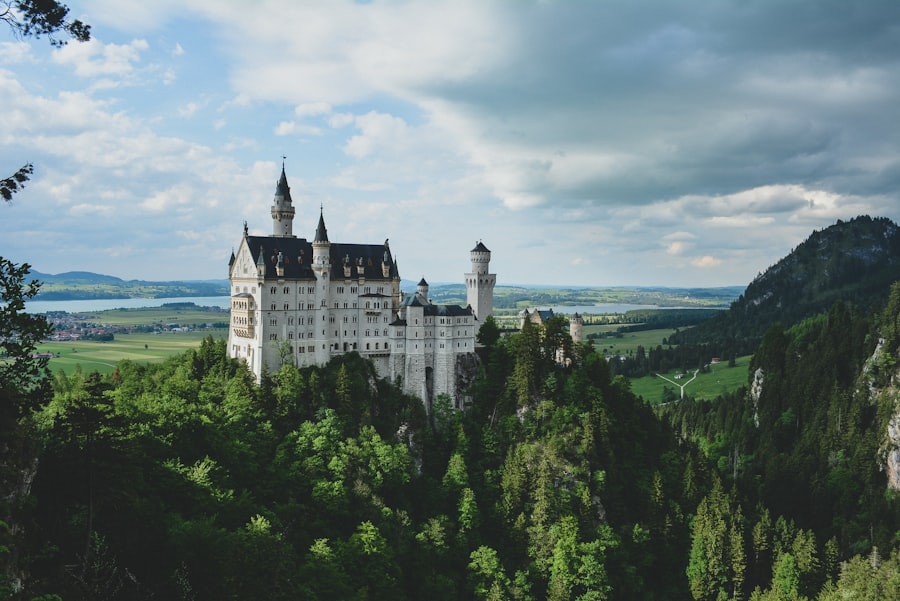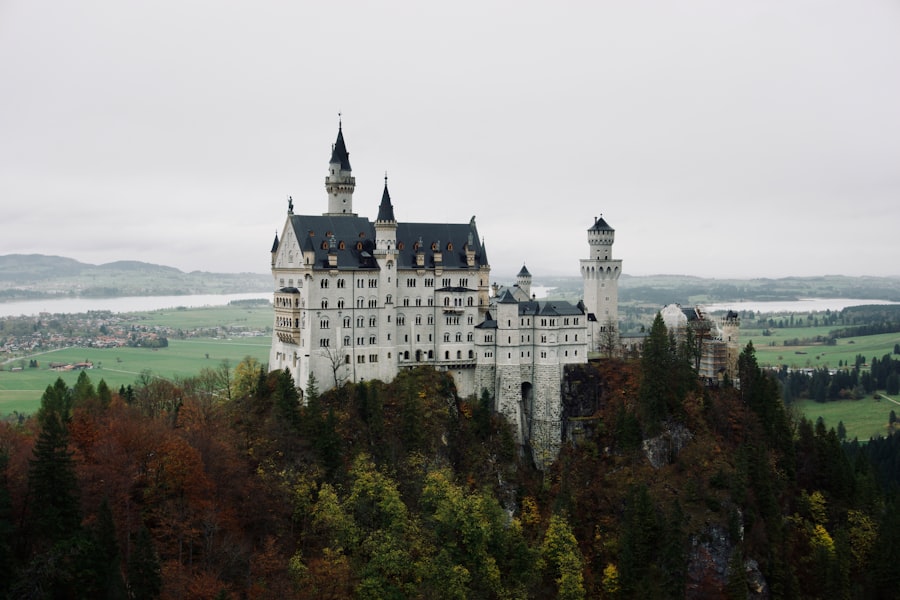
Germany is a nation steeped in history, with a tapestry of landmarks that narrate the tales of its past. From the remnants of ancient Roman settlements to the grandeur of medieval castles, the country is a treasure trove for history enthusiasts. One of the most iconic historical sites is the Brandenburg Gate in Berlin, a neoclassical monument that has stood since the 18th century.
Originally commissioned by King Frederick William II of Prussia, it symbolizes peace and unity. The gate has witnessed pivotal moments in German history, including the fall of the Berlin Wall in 1989, making it a powerful emblem of the nation’s reunification. Another significant landmark is Neuschwanstein Castle, nestled in the Bavarian Alps.
Commissioned by King Ludwig II in the 19th century, this fairy-tale castle was inspired by Richard Wagner’s operas and reflects the romantic ideals of the time. Its picturesque setting and stunning architecture attract millions of visitors each year, who are captivated by its enchanting beauty and the legends surrounding its creation. The castle not only serves as a reminder of Bavaria’s royal past but also as a symbol of the artistic and cultural movements that flourished during Ludwig’s reign.
Key Takeaways
- Germany’s historical landmarks, such as the Brandenburg Gate and Neuschwanstein Castle, offer a glimpse into the country’s rich heritage.
- From the stunning Black Forest to the picturesque Rhine Valley, Germany’s natural wonders showcase the beauty of its diverse landscapes.
- Germany’s cultural delights, including the Berlin Philharmonic and Oktoberfest, highlight the country’s vibrant art, music, and festival scene.
- Sampling German cuisine, from hearty sausages to delectable pastries, is a culinary adventure not to be missed.
- Germany’s modern marvels, such as the Autobahn and the Berlin Wall Memorial, demonstrate the country’s innovation and technological advancements.
- Off-the-beaten-path destinations like the charming town of Rothenburg ob der Tauber offer hidden gems waiting to be explored in Germany.
Natural Wonders: The Beauty of Germany’s Landscapes
Germany’s landscapes are as diverse as its history, offering a stunning array of natural wonders that range from rolling hills to majestic mountains. The Black Forest, known for its dense woods and charming villages, is a prime example of Germany’s natural beauty. This region is famous for its cuckoo clocks and traditional crafts, but it also boasts numerous hiking trails that allow visitors to immerse themselves in its serene environment.
The forest is home to diverse wildlife, including deer and wild boar, and its picturesque scenery has inspired countless fairy tales and legends. In contrast to the lush greenery of the Black Forest, the Bavarian Alps present a dramatic landscape characterized by towering peaks and crystal-clear lakes. The Zugspitze, Germany’s highest mountain, offers breathtaking views and a range of outdoor activities year-round, from skiing in winter to hiking in summer.
The nearby Eibsee lake, with its turquoise waters surrounded by rugged mountains, is a popular spot for swimming and picnicking. These natural wonders not only provide recreational opportunities but also serve as a reminder of Germany’s commitment to preserving its environment and promoting sustainable tourism.
Cultural Delights: Art, Music, and Festivals in Germany

Germany’s cultural scene is vibrant and multifaceted, reflecting its rich artistic heritage and contemporary creativity. The country has produced some of the world’s most renowned composers, including Johann Sebastian Bach, Ludwig van Beethoven, and Richard Wagner. Cities like Leipzig and Bayreuth are celebrated for their musical legacies, with venues such as the Gewandhaus and the Bayreuth Festival attracting music lovers from around the globe.
The annual Oktoberfest in Munich is another cultural highlight, where millions gather to celebrate Bavarian traditions with music, dance, and, of course, beer. Art lovers will find Germany equally captivating, with numerous museums and galleries showcasing both classical and modern works. The Museum Island in Berlin is a UNESCO World Heritage site that houses five world-renowned museums, including the Pergamon Museum and the Alte Nationalgalerie.
These institutions offer a glimpse into ancient civilizations and modern art movements alike. Additionally, contemporary art scenes thrive in cities like Berlin and Düsseldorf, where galleries and street art contribute to an ever-evolving cultural landscape that challenges traditional norms.
Culinary Adventures: Sampling the Flavors of German Cuisine
| German Dish | Ingredients | Preparation |
|---|---|---|
| Sauerbraten | Beef, vinegar, spices | Marinate beef, roast, simmer in sauce |
| Bratwurst | Pork, veal, spices | Grill or pan-fry until browned |
| Schnitzel | Pork or veal, breadcrumbs | Pound meat, coat in breadcrumbs, fry |
| Black Forest Cake | Chocolate, cherries, whipped cream | Layer cake with cherries and cream |
German cuisine is a reflection of the country’s regional diversity and rich agricultural heritage. Each region boasts its own specialties, making culinary exploration an exciting journey through flavors and traditions. In Bavaria, hearty dishes like Weisswurst (white sausage) served with sweet mustard and pretzels are staples that embody the region’s culinary identity.
The famous Oktoberfest not only celebrates beer but also showcases traditional Bavarian fare that delights locals and tourists alike. In contrast, northern Germany offers a different gastronomic experience with its emphasis on seafood. Dishes such as Labskaus—a hearty mix of corned beef, potatoes, and herring—highlight the region’s maritime influences.
The Hanseatic city of Hamburg is particularly known for its fish markets and fresh catches from the North Sea. Furthermore, Germany’s burgeoning wine regions, such as the Mosel Valley, produce exquisite Rieslings that pair beautifully with local dishes. This culinary diversity not only satisfies the palate but also tells stories of regional traditions and historical influences.
Modern Marvels: Innovation and Technology in Germany
Germany stands at the forefront of innovation and technology, driven by a robust economy and a commitment to research and development. The country is home to some of the world’s leading automotive manufacturers, including Volkswagen, BMW, and Mercedes-Benz. These companies are not only known for their engineering excellence but also for their pioneering efforts in sustainable mobility solutions.
Electric vehicles are becoming increasingly prevalent on German roads as manufacturers invest heavily in green technologies to meet environmental standards. In addition to automotive advancements, Germany excels in various fields such as renewable energy, biotechnology, and information technology. The country has made significant strides in transitioning to renewable energy sources, with wind and solar power playing crucial roles in its energy landscape.
Research institutions such as the Max Planck Society and Fraunhofer Society contribute to groundbreaking discoveries that enhance Germany’s reputation as a global leader in innovation.
Hidden Gems: Off-the-Beaten-Path Destinations in Germany

While Germany boasts many well-known attractions, it also harbors hidden gems that offer unique experiences away from the crowds. One such destination is Görlitz, a charming town located on the border with Poland. Known for its well-preserved architecture that spans several centuries, Görlitz features stunning examples of Gothic, Renaissance, and Baroque styles.
The town’s picturesque streets have served as backdrops for numerous films, earning it the nickname “Görliwood.” Visitors can explore its quaint cafes and boutiques while enjoying a leisurely stroll along the Neisse River. Another lesser-known treasure is the Spreewald region, located just south of Berlin. This UNESCO Biosphere Reserve is characterized by its intricate network of waterways lined with lush greenery.
Visitors can navigate these serene canals by canoe or traditional wooden punts while sampling local delicacies such as Spreewald gherkins—crunchy pickles that are a regional specialty. The area is also rich in folklore and traditions, making it an ideal destination for those seeking an authentic experience away from typical tourist routes.
Each aspect contributes to an understanding of what makes Germany unique—a blend of tradition and modernity that continues to captivate visitors from around the world.
If you’re intrigued by the diverse and rich cultural tapestry of Germany, you might also find interest in exploring other parts of the world. For instance, Cambodia offers a similarly profound historical and cultural experience. To learn more about what Cambodia has to offer, from its ancient temples to its vibrant cities, you can read the related article on Cambodia Facts and Places to Visit. This article provides insights into the country’s history, key attractions, and essential travel tips, making it a great resource for planning your next adventure.
FAQs
What are some interesting facts about Germany?
– Germany is the most populous country in the European Union.
– The country is known for its rich history, culture, and contributions to the fields of science, technology, and art.
– Germany is famous for its beer, sausages, and bread, and it is also a leading producer of automobiles and machinery.
What are some popular places to visit in Germany?
– Berlin, the capital city, is known for its vibrant art scene, historical landmarks, and nightlife.
– Munich is famous for its Oktoberfest celebration, as well as its beautiful architecture and museums.
– The Black Forest, with its picturesque landscapes and charming villages, is a popular destination for nature lovers.
What are some must-see sights in Germany?
– The Brandenburg Gate in Berlin is an iconic symbol of German unity and peace.
– Neuschwanstein Castle, a fairy-tale-like castle nestled in the Bavarian Alps, is a popular tourist attraction.
– The Cologne Cathedral, a stunning Gothic masterpiece, is a UNESCO World Heritage site and a must-see for architecture enthusiasts.



